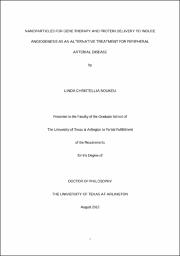| dc.description.abstract | Peripheral arterial disease (PAD) is defined as a slow, progressive disorder of the lower extremity arterial vessels characterized by chronic narrowing that often results in occlusion and is associated with loss of functional capacity. Although the PAD occurrence rate is increasing in the elderly population, outcomes with current treatment strategies are suboptimal. Hence, there is an urgent need to develop new technologies that overcome limitations of traditional modalities for PAD detection and therapy. In this research, nanoparticles have been developed and used as carriers for various therapeutic agents to treat PAD.
In particular, via protein/gene delivery, we developed and formulated nanoparticles (NPs) loaded with Erythropoietin (Epo) protein and/or complimentary deoxyribonucleic acid (cDNA) plasmids of the Epo receptor (EpoR) to enhance angiogenesis and/or restore vessel functions for use as an alternative PAD treatment. Epo and EpoR signaling pathways are selected for this research as they have been shown to play an important role in angiogenesis, cellular protection and proliferation of endothelial cells under the oxidative stress and hypoxic conditions, especially that of the ischemia. We observed that the fabricated NPs showed positive surface charges with average diameters of around 200 nm, demonstrated a sustained release of the payloads (e.g. Epo and EpoR cDNA), and maintained their stability in different aqueous solutions. In addition, these NPs were hemocompatible with very low levels of hemolysis and produced a blood clotting time similar to that of the normal control. Moreover, these NPs were cyto-compatible with HUVECs, and the cellular uptake was dose-dependent. Despite no synergism observed in EpoR/Epo NPs compared to that of either Epo NPs or EpoR NPs, all three NPs (e.g. Epo NPs, EpoR NPs, and EpoR/Epo NPs) demonstrated to have potential angiogenic properties in HUVECs via enhanced cell proliferation, a boost in cell migration, provided cell protection in the stressed condition, and promoted tube formation under hypoxia compared to those of control (blank) NPs, free reagents, and no treatment.
Lastly, we focused on applying gene therapy as a therapeutic approach in inducing angiogenesis in the ischemic hindlimb mice. We formulate and characterized NPs loaded with either single or a combination of sense and antisense cDNA plasmids to enhance angiogenesis and restore vessel functions in the ischemic tissues. The investigated nanoparticles are EpoR NPs, RopE NPs (or anti-sense erythropoietin receptor cDNA) and EpoR/RopE NPs. For this study, we investigated how these NPs effectively improved angiogenesis in vitro and in vivo and whether a combination used is better than that of a single one. EpoR is selected for this research for its important role in inducing angiogenesis, maintaining cell protection, and facilitating proliferation of endothelial cells under oxidative stress and hypoxic conditions, especially those exposed to ischemia, while Rope has been reported for increasing EpoR protein expression. From this work, we can conclude that the fabricated positive surface charge NPs had an average diameter of around 200 nm and demonstrated a biphasic release (burst and sustained) of the payloads, EpoR, RopE, and/or EpoR/RopE cDNA plasmids. They also facilitated cell proliferation, provided cell protection, and induced cell migration properties in vitro. In the ischemic tissue, via angiogenesis, these NPs restored limb functions by its rapid, improved secretion of angiogenic proteins, capillary density, blood flow reperfusion and stronger muscle strength properties. | |


